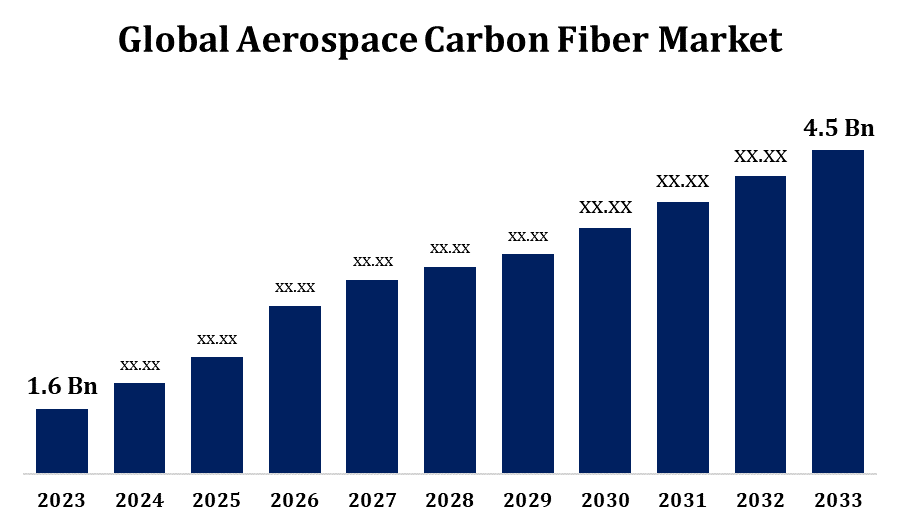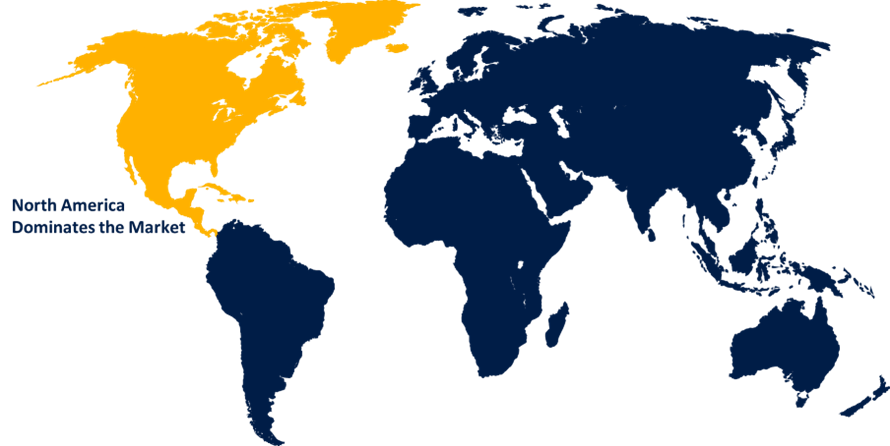Global Aerospace Carbon Fiber Market Size, Share, and COVID-19 Impact Analysis, By Application (Commercial Fixed-Wing Aircraft, Military Fixed-Wing Aircraft, and Rotorcraft), and By Region (North America, Europe, Asia-Pacific, Latin America, Middle East, and Africa), Analysis and Forecast 2023 - 2033
Industry: Aerospace & DefenseGlobal Aerospace Carbon Fiber Market Insights Forecasts to 2033
- The Aerospace Carbon Fiber Market was valued at USD 1.6 Billion in 2023.
- The Market Size is Growing at a CAGR of 10.89% from 2023 to 2033.
- The Worldwide Aerospace Carbon Fiber Market Size is Expected to reach USD 4.5 Billion by 2033.
- Asia Pacific is Expected to Grow the fastest during the forecast period.

Get more details on this report -
The Global Aerospace Carbon Fiber Market Size is Expected to reach USD 4.5 Billion by 2033, at a CAGR of 10.89% during the forecast period 2023 to 2033.
The aerospace carbon fiber market is experiencing significant growth, driven by the increasing demand for lightweight materials that enhance fuel efficiency and performance in aircraft. Carbon fiber composites offer superior strength-to-weight ratios, making them ideal for applications in commercial and military aviation. Key players in the market are investing in advanced manufacturing techniques and research to improve material properties and reduce production costs. The growing emphasis on sustainable practices in the aerospace sector also boosts the adoption of carbon fiber, as it helps reduce carbon emissions. With the rising production of aircraft and a shift towards more eco-friendly technologies, the aerospace carbon fiber market is poised for robust expansion in the coming years, presenting lucrative opportunities for manufacturers and suppliers alike.
Aerospace Carbon Fiber Market Value Chain Analysis
The aerospace carbon fiber market value chain involves several key stages, from raw material sourcing to end-user applications. It begins with the extraction and processing of precursor materials, primarily polyacrylonitrile (PAN), which are then transformed into carbon fiber through controlled heating processes. Manufacturers supply these carbon fibers to composite producers, who create carbon fiber-reinforced polymers (CFRPs) using resins like epoxy. These composites are molded into aerospace components such as fuselages, wings, and interior parts. Tier 1 and Tier 2 suppliers integrate these parts into aircraft systems, which are then delivered to original equipment manufacturers (OEMs) like Boeing and Airbus. The value chain is supported by technological advancements in manufacturing and recycling, with a focus on reducing costs and improving sustainability throughout the aerospace industry.
Aerospace Carbon Fiber Market Opportunity Analysis
The aerospace carbon fiber market presents significant opportunities, driven by the growing demand for lightweight, fuel-efficient aircraft and advancements in composite materials. As airlines and military sectors aim to reduce operational costs and carbon emissions, carbon fiber-reinforced composites are increasingly favored for their high strength-to-weight ratio. Emerging trends, such as the rise of electric and hybrid aircraft, offer additional growth prospects for carbon fiber applications. Furthermore, the expansion of space exploration programs and unmanned aerial vehicles (UAVs) creates new avenues for market players. Innovations in carbon fiber recycling and production processes, aimed at cost reduction and enhanced material performance, are likely to unlock further opportunities. With the aerospace sector prioritizing sustainability, carbon fiber’s role in shaping the future of aviation is poised to grow significantly.
Global Aerospace Carbon Fiber Market Report Coverage
| Report Coverage | Details |
|---|---|
| Base Year: | 2023 |
| Market Size in 2023: | USD 1.6 Billion |
| Forecast Period: | 2023-2033 |
| Forecast Period CAGR 2023-2033 : | 10.89% |
| 2033 Value Projection: | USD 4.5 Billion |
| Historical Data for: | 2019-2022 |
| No. of Pages: | 193 |
| Tables, Charts & Figures: | 110 |
| Companies covered:: | OJSC SvetlogorskKhimvolokno, HYOSUNG, NIPPON STEEL CORPORATION, Solvay, TEIJIN LIMITED, Hexcel Corporation, Mitsubishi Chemical Group Corporation, SGL Carbon, Toray Industries, Inc., DowAksa, and Others |
| Pitfalls & Challenges: | Covid-19 Empact, Challenges, Growth, Analysis. |
Get more details on this report -
Market Dynamics
Aerospace Carbon Fiber Market Dynamics
Rapid adoption of modern manufacturing technologies
The aerospace carbon fiber market is witnessing rapid adoption of modern manufacturing technologies to meet the growing demand for advanced lightweight materials. Techniques such as automated fiber placement (AFP) and resin transfer molding (RTM) are revolutionizing the production of carbon fiber-reinforced polymers (CFRPs) by increasing precision, reducing waste, and shortening production cycles. Additive manufacturing (3D printing) is also gaining traction, enabling complex carbon fiber components to be produced with greater customization and efficiency. These innovations not only lower manufacturing costs but also improve the structural integrity of aerospace parts. Additionally, advancements in recycling technologies for carbon fiber composites are fostering sustainability. As aircraft manufacturers strive to optimize performance while reducing emissions, the integration of cutting-edge production methods is accelerating the use of carbon fiber in the aerospace industry.
Restraints & Challenges
The aerospace carbon fiber market faces several challenges despite its growth potential. High production costs remain a major hurdle, as the complex manufacturing processes of carbon fiber-reinforced polymers (CFRPs) require significant energy and specialized equipment. Additionally, the long production cycles can lead to supply chain inefficiencies, particularly when scaling up for mass production. Recycling carbon fiber composites also poses difficulties due to the degradation of fiber properties during reprocessing, limiting the material's reuse. Furthermore, the aerospace sector’s stringent regulatory requirements demand extensive testing and certification, which can delay the adoption of new carbon fiber technologies. The reliance on a few raw material suppliers and geopolitical factors can cause supply chain disruptions. Addressing these challenges is crucial for wider carbon fiber adoption in the aerospace industry.
Regional Forecasts
North America Market Statistics

Get more details on this report -
North America is anticipated to dominate the Aerospace Carbon Fiber Market from 2023 to 2033. The region, home to major aircraft manufacturers like Boeing, Lockheed Martin, and Northrop Grumman, has a high demand for advanced materials to enhance aircraft performance and fuel efficiency. The U.S. government’s focus on modernizing military fleets and expanding space exploration initiatives further boosts the use of carbon fiber-reinforced composites. Additionally, North America's strong research and development infrastructure supports continuous innovation in carbon fiber production and applications. The growing focus on sustainability and the reduction of carbon emissions in aviation is also encouraging the adoption of carbon fiber materials. With advancements in manufacturing technologies, North America is expected to maintain its leadership in the aerospace carbon fiber market.
Asia Pacific Market Statistics
Asia Pacific is witnessing the fastest market growth between 2023 to 2033. Emerging nations are investing heavily in aircraft manufacturing and aerospace infrastructure, leading to higher demand for carbon fiber-reinforced composites. China, in particular, is developing its own aerospace capabilities, including the COMAC C919 aircraft, which uses carbon fiber to enhance fuel efficiency and reduce weight. Japan, a major carbon fiber producer, is advancing the material’s applications through partnerships with global aerospace firms. Additionally, the region’s growing focus on sustainable aviation and carbon emissions reduction is accelerating the adoption of carbon fiber. Asia Pacific is expected to see strong growth in the aerospace carbon fiber market as it continues to strengthen its aerospace sector.
Segmentation Analysis
Insights by Application
The commercial fixed wing aircraft segment accounted for the largest market share over the forecast period 2023 to 2033. Carbon fiber-reinforced composites (CFRPs) are extensively used in the production of aircraft components such as fuselage, wings, and tail sections, offering a high strength-to-weight ratio and improved durability compared to traditional materials like aluminum. With global air travel rebounding and airlines focusing on reducing carbon emissions, demand for fuel-efficient, next-generation aircraft such as Boeing 787 and Airbus A350, which incorporate substantial amounts of carbon fiber, is rising. This trend is further supported by efforts to extend aircraft lifespan, reduce maintenance costs, and improve aerodynamics, making the commercial fixed-wing aircraft segment a key driver of market expansion.
Recent Market Developments
- In March 2023, SGL Carbon has introduced the new SIGRAFIL T50-4.9/235 carbon fiber, expanding its material portfolio with this advanced fiber designed for high-strength pressure vessels.
Competitive Landscape
Major players in the market
- OJSC SvetlogorskKhimvolokno
- HYOSUNG
- NIPPON STEEL CORPORATION
- Solvay
- TEIJIN LIMITED
- Hexcel Corporation
- Mitsubishi Chemical Group Corporation
- SGL Carbon
- Toray Industries, Inc.
- DowAksa
- Others
Market Segmentation
This study forecasts revenue at global, regional, and country levels from 2023 to 2033.
Aerospace Carbon Fiber Market, Application Analysis
- Commercial Fixed-Wing Aircraft
- Military Fixed-Wing Aircraft
- Rotorcraft
Aerospace Carbon Fiber Market, Regional Analysis
- North America
- US
- Canada
- Mexico
- Europe
- Germany
- Uk
- France
- Italy
- Spain
- Russia
- Rest of Europe
- Asia Pacific
- China
- Japan
- India
- South Korea
- Australia
- Rest of Asia Pacific
- South America
- Brazil
- Argentina
- Rest of South America
- Middle East & Africa
- UAE
- Saudi Arabia
- Qatar
- South Africa
- Rest of the Middle East & Africa
Frequently Asked Questions (FAQ)
-
1. What is the market size of the Aerospace Carbon Fiber Market?The global Aerospace Carbon Fiber Market is expected to grow from USD 1.6 billion in 2023 to USD 4.5 billion by 2033, at a CAGR of 10.89% during the forecast period 2023-2033.
-
2. Who are the key market players of the Aerospace Carbon Fiber Market?Some of the key market players of the market are OJSC SvetlogorskKhimvolokno, HYOSUNG, NIPPON STEEL CORPORATION, Solvay, TEIJIN LIMITED, Hexcel Corporation, Mitsubishi Chemical Group Corporation, SGL Carbon, Toray Industries, Inc., DowAksa.
-
3. Which segment holds the largest market share?The commercial fixed wing aircraft segment holds the largest market share and is going to continue its dominance.
-
4. Which region dominates the Aerospace Carbon Fiber Market?North America dominates the Aerospace Carbon Fiber Market and has the highest market share.
Need help to buy this report?